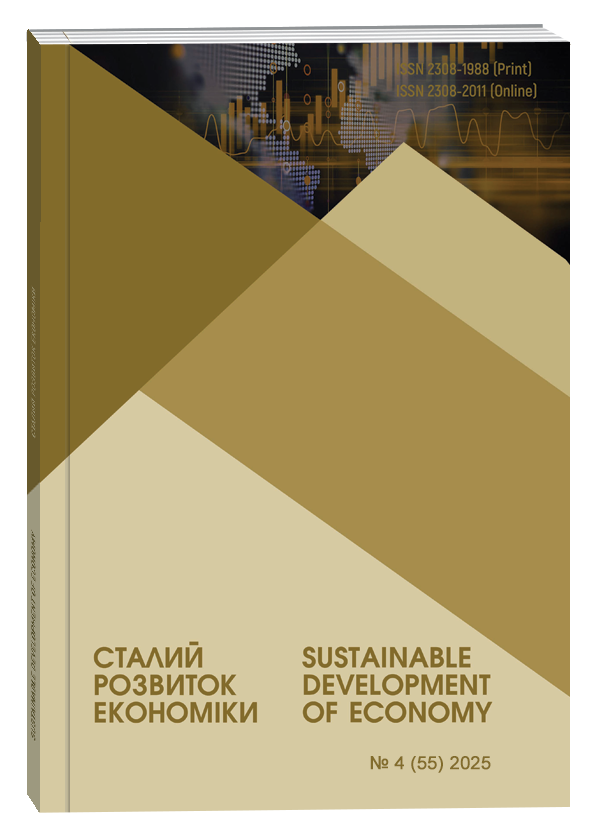IMMERSIVE TECHNOLOGIES IN HIGHER EDUCATION: CHARACTERISTICS, APPLICATION POTENTIAL, AND ROLE IN QUALITY ASSURANCE
Abstract
The article is devoted to identifying the specific features of applying immersive technologies in higher education, exploring their potential, and determining their role in ensuring the quality of the educational process in higher education institutions of Ukraine. The relevance of the research lies in the need to introduce immersive technologies into Ukraine’s higher education system to improve the quality of student training, bridge the gap between theoretical knowledge and practical skills, and enhance graduates’ competitiveness in both national and global labor markets. The research employed the following methods: analysis of scientific literature, synthesis, comparative analysis, abstraction, tabular method, inductive and deductive methods. The study examines the essence of the concept of “immersive technologies” and provides a characterization of different types of XR-technologies, including virtual reality (VR), augmented reality (AR), and mixed reality (MR). The experience of using immersive technologies in foreign higher education institutions is reviewed, revealing that these technologies are a significant factor in shaping new approaches to the implementation of the educational process, enhancing the acquisition of theoretical knowledge, and developing practical skills critical for real-world conditions. Their implementation also contributes to improving the overall quality of education. The potential of applying XR-technologies in Ukrainian higher educational institutions is disclosed, along with the advantages, limitations, and risks of integrating immersive technologies into the educational environment. It is established that when developing educational content using XR-technologies, it is necessary to consider the risks of excessive cognitive load and emotional exhaustion that may result from prolonged or intensive immersion in virtual environments. Special attention is given to ethical aspects and tools for ensuring compliance with the principles of academic integrity when using immersive technologies in the learning process. The importance of implementing immersive technologies in Ukrainian higher educational institutions to ensure the quality of the educational process is substantiated. It is concluded that the creation of immersive educational and research environments in national higher educational institutions is an important factor in stimulating the development of innovative ecosystems at the local, regional, and national levels.
References
ISO/IEC TR 23844:2023(en): Information technology for learning, education, and training - Immersive content and technology. Online Browsing Platform (OBP). URL: https://www.iso.org/obp/ui/en/#iso:std:iso-iec:tr:23844:ed-1:v1:en
Extended Reality (XR). Interaction Design Foundation. URL: https://www.interaction-design.org/literature/topics/extended-reality-xr
Metaverse. Merriam-Webster. URL: https://www.merriam-webster.com/dictionary/metaverse
Milgram P., Kishino F. A Taxonomy of Mixed Reality Visual Displays. IEICE Transactions on Information and Systems. IEICE Transactions on Information and Systems. 1994. Vol. E77-D. № 12 (12). P. 1321-1329. URL: https://www.researchgate.net/publication/231514051_A_Taxonomy_of_Mixed_Reality_Visual_Displays
Azuma R.T. A Survey of Augmented Reality. Presence: Teleoperators and Virtual Environments. 1997. Vol. 6. No. 4. P. 355–385. DOI: https://doi.org/10.1162/pres.1997.6.4.355
Alan B. Craig. Understanding Augmented Reality: Concepts and Applications. Amsterdam: Morgan Kaufmann, 2013. 296 p. ISBN: 978-0-240-82109-8. DOI: https://doi.org/10.1016/C2011-0-07249-6
What is Mixed Reality? Microsoft. URL: https://learn.microsoft.com/en-us/windows/mixed-reality/discover/mixed-reality
Speicher M., Hall B. D., Nebeling M. What is Mixed Reality? Proceedings of the 2019 CHI Conference on Human Factors in Computing Systems. 2019. P. 1–15. DOI: https://doi.org/10.1145/3290605.3300767
Jerald J. The VR Book: Human-Centered Design for Virtual Reality. San Rafael: Morgan & Claypool, 2015. 523 p. - ISBN 978-1-970001-02-2.
Stanford School of Medicine. URL: https://med.stanford.edu
Massachusetts Institute of Technology. URL: https://web.mit.edu
Karlsruhe Institute of Technology. URL: https://www.kit.edu/english/
University of Tokyo. URL: https://www.u-tokyo.ac.jp
Harvard University. URL: https://www.harvard.edu
University of Maryland. URL: https://mith.umd.edu
University College London. URL: https://www.ucl.ac.uk
University of Barcelona. URL: https://www.event-lab.org
INSEAD Business School. URL:https://www.insead.edu
Буров О.Ю., Пінчук О.П., Литвинова С.Г. Імерсивні технології та цифрове навчання: вплив, можливості та пом’якшення ризику. Цифрова трансформація відкритих науково-освітніх середовищ: монографія. Київ: Ін-т цифровізації освіти НАПН України. 2024. C.35-53.
Ensuring Academic Integrity in Metaverse Learning Environments. The Swiss Quality Consulting. URL: https://theswissquality.ch/ensuring-academic-integrity-in-metaverse-learning-environments/
ISO/IEC TR 23844:2023(en) Information technology for learning, education, and training - Immersive content and technology. Online Browsing Platform (OBP). Available at: https://www.iso.org/obp/ui/en/#iso:std:iso-iec:tr:23844:ed-1:v1:en (in English)
Extended Reality (XR). Interaction Design Foundation. Available at: https://www.interaction-design.org/literature/topics/extended-reality-xr (in English)
Metaverse. Merriam-Webster. Available at: https://www.merriam-webster.com/dictionary/metaverse (in English)
Milgram P., Kishino F. (1994) A Taxonomy of Mixed Reality Visual Displays. IEICE Transactions on Information and Systems, vol. E77-D, no. 12, pp. 1321–1329. Available at: https://www.researchgate.net/publication/231514051_A_Taxonomy_of_Mixed_Reality_Visual_Displays (in English)
Azuma R.T. (1997) A Survey of Augmented Reality. Presence: Teleoperators and Virtual Environments, vol. 6, no. 4, pp. 355–385. DOI: https://doi.org/10.1162/pres.1997.6.4.355 (in English)
Craig A. B. (2013) Understanding Augmented Reality: Concepts and Applications. Amsterdam: Morgan Kaufmann, 296 p. DOI: https://doi.org/10.1016/C2011-0-07249-6 (in English)
What is Mixed Reality? Microsoft. Available at: https://learn.microsoft.com/en-us/windows/mixed-reality/discover/mixed-reality (in English)
Speicher M., Hall B. D., Nebeling M. (2019) What is Mixed Reality? Proceedings of the 2019 CHI Conference on Human Factors in Computing Systems, pp. 1–15. DOI: https://doi.org/10.1145/3290605.3300767 (in English)
Jerald J. (2015) The VR Book: Human-Centered Design for Virtual Reality. San Rafael: Morgan & Claypool, p. 523. (in English)
Stanford School of Medicine. Available at: https://med.stanford.edu (in English)
Massachusetts Institute of Technology. Available at: https://web.mit.edu (in English)
Karlsruhe Institute of Technology. Available at: https://www.kit.edu/english/ (in English)
University of Tokyo. Available at: https://www.u-tokyo.ac.jp (in English)
Harvard University. Available at: https://www.harvard.edu (in English)
University of Maryland. Available at: https://mith.umd.edu (in English)
University College London. Available at: https://www.ucl.ac.uk (in English)
University of Barcelona. Available at: https://www.event-lab.org (in English)
INSEAD Business School. Available at: https://www.insead.edu (in English)
Burov O.Yu., Pinchuk O.P., Lytvynova S.H. (2024) Imersevni tekhnolohii ta tsyfrove navchannia: vplyv, mozhlyvosti ta pom’yakshennia ryzyku [Immersive technologies and digital learning: impact, opportunities, and risk mitigation]. Tsyfrova transformatsiia vidkrytykh naukovo-osvitnikh seredovishch: monohrafiya. Kyiv: Instytut tsyfroizatsii osvity NAPN Ukrainy, pp. 35–53. (in Ukrainian)
Ensuring Academic Integrity in Metaverse Learning Environments. The Swiss Quality Consulting. Available at: https://theswissquality.ch/ensuring-academic-integrity-in-metaverse-learning-environments/ (in English)


